Griffiths D. Head First Statistics
Подождите немного. Документ загружается.

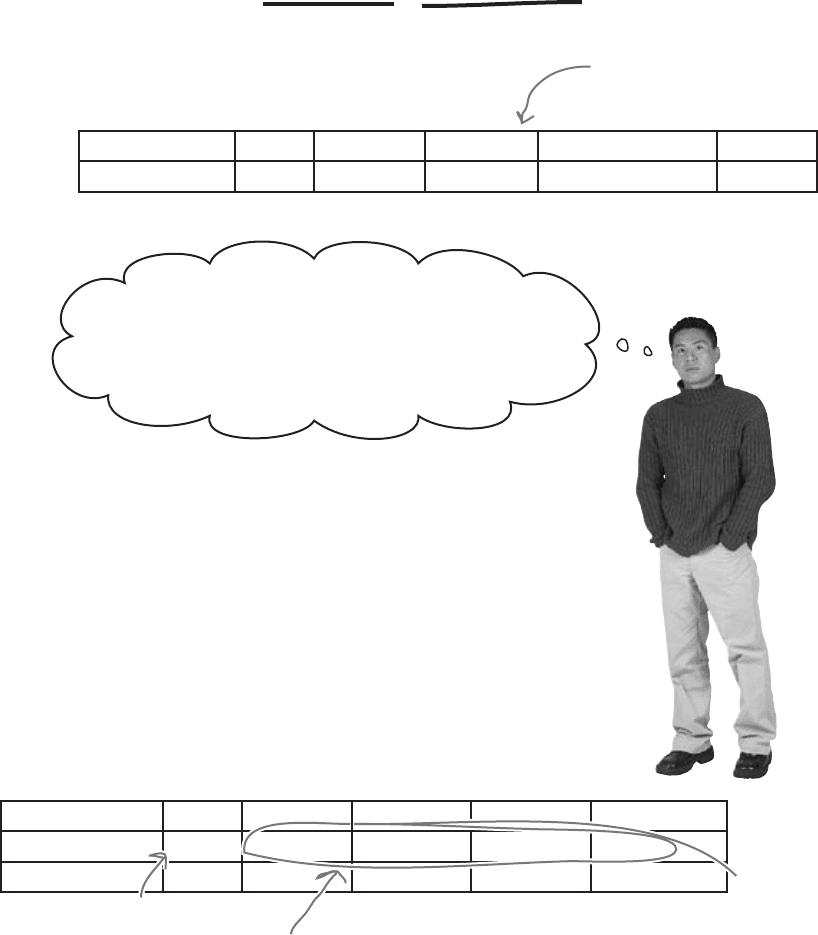
you are here 4 201
using discrete probability distributions
Here are the probabilities of the different winning combinations
on the slot machine.
Combination None Lemons Cherries $s/cherry Dollars
Gain -$1 $4 $9 $14 $19
Probability
0.977 0.008 0.008 0.006 0.001
We don’t just want to know the probability of
winning, we want to know how much we stand to
win.
The probabilities are currently written in terms of combinations of
symbols, which makes it hard to see at a glance what out gain will be.
We don’t have to write them like this though. Instead of writing the
probabilities in terms of slot machine images, we can write them in
terms of how much we win or lose on each game. All we need to do
is take the amount we’ll win for each combination, and subtract the
amount we’ve paid for the game.
Combination None Lemons Cherries Dollars/cherry Dollars
Probability
0.977 0.008 0.008 0.006 0.001
The table gives us the probability distribution of the
winnings, a set of the probabilities for every possible gain
or loss for our slot machine.
This is just a summary of the
probabilities we just worked out.
This looks useful, but I wonder if we can take it one
step further. We’ve found the probabilities of getting
each of the winning combinations, but what we’re
really interested in is how much we’ll win or lose.
These are the same
probabilities, just written in
terms of how much we’ll gain.
We lose $1 if we don’t hit a
winning combination.
Our gain for hitting each winning
combination: the payoff minus the $1
we paid to play.
We can compose a probability distribution for the slot machine
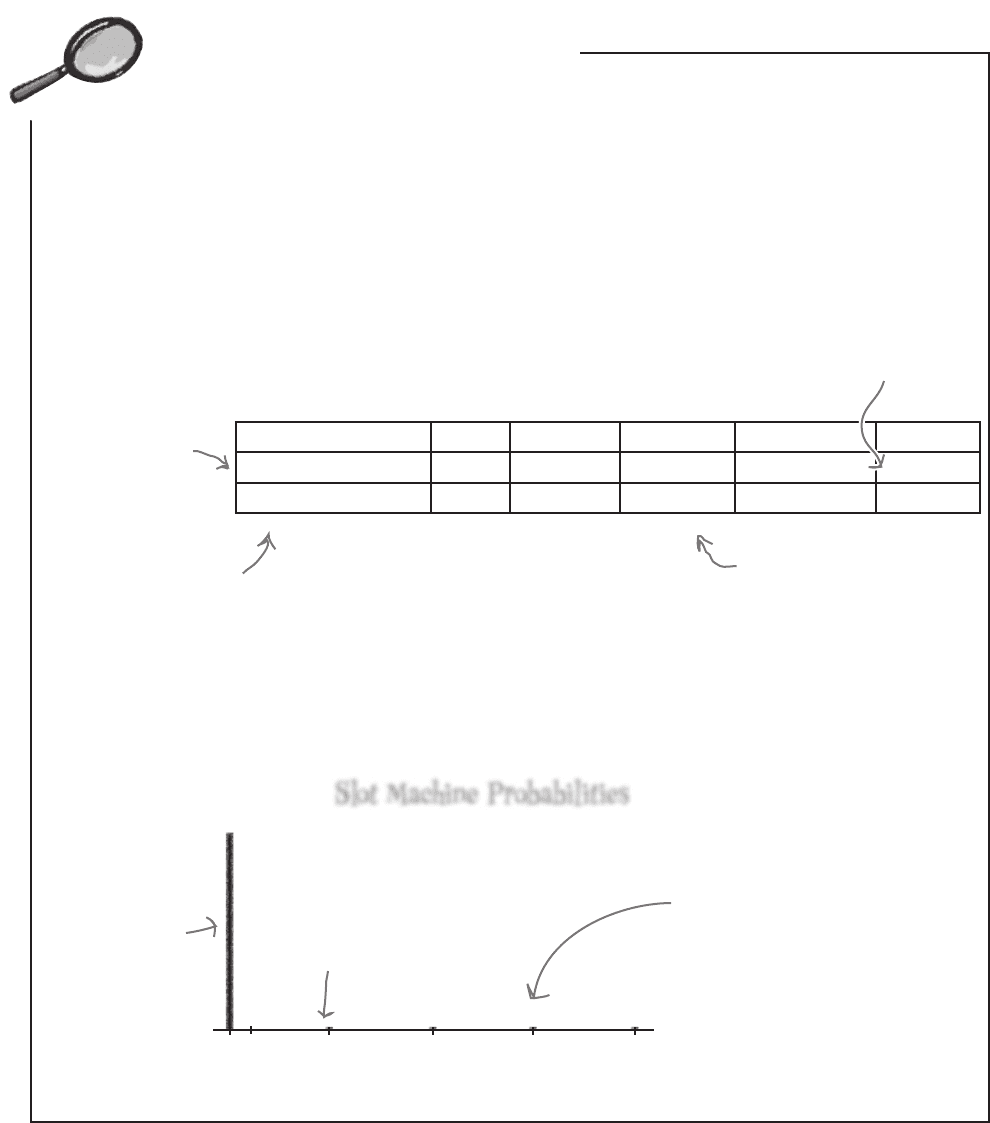
202 Chapter 5
Combination None Lemons Cherries $s/cherry Dollars
x -1 4 9 14 19
P(X = x)
0.977 0.008 0.008 0.006 0.001
Probability Distributions Up Close
When you derived the probabilities of the slot machine, you calculated the
probability of making each gain or loss. In other words, you calculated the
probability distribution of a random variable, which is a variable that can
takes on a set of values, where each value is associated with a specific probability.
In the case of Fat Dan’s slot machine, the random variable represents the
amount we’ll gain in each game.
When we want to refer to a random variable, it’s usual to represent it by a capital
letter, like X or Y. The particular values that the variable can take are represented
by a lowercase letter—for example, x or y. Using this notation, P(X = x) is a way
of saying “the probability that the variable X takes a particular value x.”
Here’s our slot machine probability distribution written using this notation:
X is the variable.
The value of each
combination’s
winnings is
represented by x.
Here x is 19.
The probability that the
variable X is 9—in other
words, that the value of
the winnings is $9.
The variable is discrete. This means that it can only take exact values.
As well as giving a table of the probability distribution, we can also show the
distribution on a chart to help us visualize it. Here is a bar chart showing the slot
machine probabilities.
Slot Machine Probabilities
x
0
4 9 14 19-1
P(X = x)
The probabilities for winning
$4, $9, $14, and $19 are so
tiny, they barely register on
the graph.
The probability
of losing $1 is
nearly 1.
probability distributions in depth
In this type of bar chart,
the bars are so thin
they’re just lines

you are here 4 203
using discrete probability distributions
Why should I care about probability
distributions? All I want to know is
how much I’ll win on the slot machine.
Can I calculate that?
Once you’ve calculated a probability
distribution, you can use this information
to determine the expected outcome.
In the case of Fat Dan’s slot machine, we can use our
probability distribution to determine how much you can
expect to win or lose long-term.
Q:
Why couldn’t we have just used
the symbols instead of winnings? I’m not
sure we’ve really gained that much.
A: We could have, but we can do more
things if we have numeric data because we
can use it in calculations. You’ll see shortly
how we can use numeric data to work out
how much we can expect to win on each
game, for instance. We couldn’t have done
that if we had just used symbols.
Q:
What if I want to show probability
distributions on a Venn diagram?
A: It’s not that appropriate to show
probability distributions like that. Venn
diagrams and probability trees are useful if
you want to calculate probabilities. With a
probability distribution, the probabilities have
already been calculated.
Q:
Can you use any letter to represent
a variable?
A: Yes, you can, as long as you don’t
confuse it with anything else. It’s most
common to use letters towards the end of
the alphabet, though, such as X and Y.
Q:
Should I use the same letter for the
variable and the values? Would I ever use
X for the variable and y for the values?
A: Theoretically, there’s nothing to
stop you, but in practice you’ll find it more
confusing if you use different letters. It’s best
to stick to using the same letter for each.
Q:
You said that a discrete random
variable is one where you can say
precisely what the values are. Isn’t that
true of every variable?
A: No, it’s not. With the slot machine
winnings, you know precisely what the
winnings are going to be for each symbol
combination. You can’t get any more precise,
and it wouldn’t matter how many times you
played. For each game the possible values
remain the same.
Sometimes you’re given a range of values
where any value within the range is possible.
As an example, suppose you were asked to
measure pieces of string that are between
10 inches and 11 inches long. The length
could be literally any value within that range.
Don’t worry about the distinction too much
for now; we’ll look at this in more detail
later on in the book. For now, every random
variable we look at will be discrete.
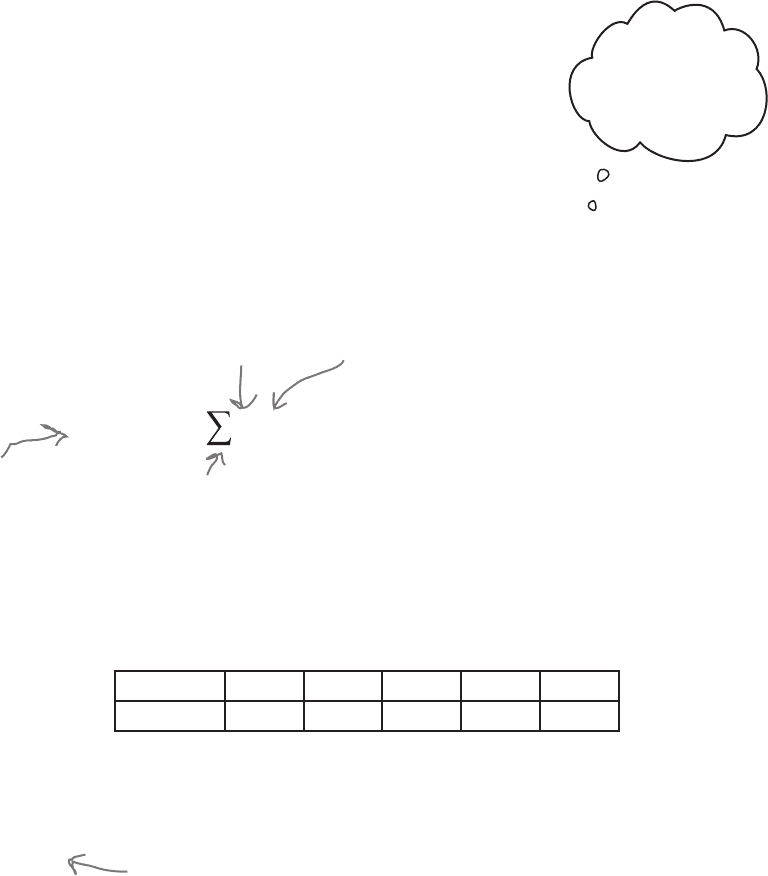
204 Chapter 5
You have a probability distribution for the amount you could
gain on the slot machines, but now you need to know how much
you can expect to win or lose long-term. You can do this by
calculating how much you can typically expect to win or lose in
each game. In other words, you can find the expectation.
The expectation of a variable X is a bit like the mean, but
for probability distributions. You even calculate it in a similar
way. To find the expectation, you multiply each value x by the
probability of getting that value, and then sum the results.
The expectation of a variable X is usually written E(X), but
you’ll sometimes see it written as μ, the symbol for the mean.
Think of the expectation and mean as twins separated at birth.
Here’s the equation for working out E(X):
x -1 4 9 14 19
P(X = x)
0.977 0.008 0.008 0.006 0.001
E(X) = xP(X = x)
E(X) is the
expectation of X
E(X) = μ
I’m the
expectation.
Treat me like
I’m mean.
Multiply each value by its probability.
Once you’ve done
multiplying, add the
whole lot up together.
Let’s use this to calculate the expectation of the slot machine
gain. Here’s a reminder of our probability distribution:
E(X) = (-1
×
0.977) + (4
×
0.008) + (9
×
0.008) + (14
×
0.006) + (19
×
0.001)
= -0.977 + 0.032 + 0.072 + 0.084 + 0.019
= -0.77
In other words, over a large number of games, you can expect
to lose $0.77 for each game. This means that if you played the
slot machine 100 times, you could expect to lose $77.
This is the amount in $’s you can expect
to gain on each pull of the lever—and it’s
negative!
Expectation gives you a prediction of the results…
expectation and variance of discrete probability distributions

you are here 4 205
using discrete probability distributions
The expectation tells you how much on average you can expect to win or
lose with each game. If you lost this amount every single time, where would
the fun be, and who would play?
Just because you can expect to lose each time you play doesn’t mean there
isn’t a small chance you’ll win big. Just like the mean, the expectation doesn’t
give the full story as the amount you stand to gain on each game could vary
a lot. How do you think we can measure this?
The amount you could win
or lose each time varies.
Here’s the jackpot - tempted?
I wonder...if expectation
is like the mean, can we
use some sort of variance?
That’s what we did before.
Probability distributions have variance.
The expectation gives the typical or average value of
a variable but it doesn’t tell you anything about how
the values are spread out. For our slot machine, this
will tell us more about the variation of our potential
winnings.
Just like we did in Chapter 3, we can use variance to
measure this spread. Let’s see how we can do this.
x
0
4 9 14 19-1
P(X = x)P(X = x)
Slot Machine Probabilities
…and variance tells you about the spread of the results
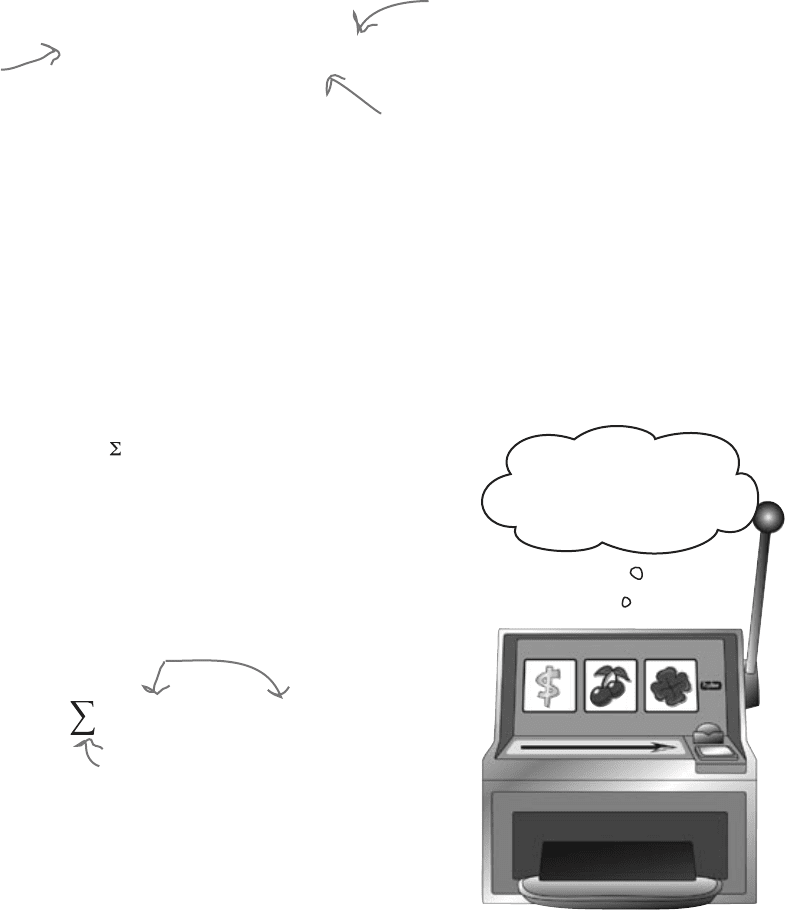
206 Chapter 5
Back in Chapter 3, we calculated the variance of a set of numbers. We worked
out (x - μ)
2
for each number, and then we took the average of these results.
We can do something similar to work out the variance of a variable X. Instead
of finding the average of (X - μ)
2
, we find its expectation. We use this
formula:
Var(X) = E(X - μ)
2
μ is the alternative way of
writing E(X).
This is the variance. A
shorthand way of referring to
the variance of X is Var(X).
We need to find the expectation
of (X - μ)
2
—but how?
Variances and probability distributions
There’s just one problem: how do we find the expectation of (X - μ)
2
?
So how do we calculate E(X - μ)
2
?
Finding E(X - μ)
2
is actually quite similar to finding E(X).
When we calculate E(X), we take each value in the probability distribution,
multiply it by its probability, and then add the results together. In other
words, we use the calculation
E(X) = xP(X = x)
When we calculate the variance of X, we calculating (x - μ)
2
for every value
x, multiply it by the probability of getting that value x, and then add the
results together.
E(X - μ)
2
= (x - μ)
2
P(X = x)
Go through each value x and
work out what (x - μ)
2
is. Then
multiply it by the probability of
getting x…
…and then add these
results together.
In other words, instead of multiplying x by its probability, you multiply
(x - μ)
2
by the probability of getting that value of x.
Var(X) measures how
widely my payouts vary.
calculating variance for discrete probability distributions

you are here 4 207
using discrete probability distributions
Let’s see if we can use this to calculate the variance of
the slot machine. To do this, we subtract μ from each
value, square the result, and then multiply each one by
the probability. As a reminder, E(X) or μ is -0.77.
Var(X) = E(X - μ)
2
= (-1+0.77)
2
×
0.977 + (4+0.77)
2
×
0.008 + (9+0.77)
2
×
0.008 + (14+0.77)
2
×
0.006 + (19+0.77)
2
×
0.001
= (-0.23)
2
×
0.977 + 4.77
2
×
0.008 + 9.77
2
×
0.008 + 14.77
2
×
0.006 + 19.77
2
×
0.001
= 0.0516833 + 0.1820232 + 0.7636232 + 1.3089174 + 0.3908529
x -1 4 9 14 19
P(X = x)
0.977 0.008 0.008 0.006 0.001
Here’s a reminder of the slot
machine probabilities.
This means that while the expectation of our winnings is -0.77, the
variance is 2.6971.
(X-μ)
2
x P(X=x)
What about the standard deviation?
Can we calculate that too?
Let’s calculate the slot machine’s variance
Would you prefer to play on a slot machine
with a high or low variance? Why?
We can use the same symbol for
standard deviation as before.
As well as having a variance, probability
distributions have a standard deviation.
It serves a similar function to the standard deviation of a set of values.
It’s a way of measuring how far away from the center you can expect
your values to be.
As before, the standard deviation is calculated by taking the square
root of the variance like this:
σ = Var(X)
This means that the standard deviation of the slot machine winnings is
√2.6971, or 1.642. This means that on average, our winnings per game
will be 1.642 away from the expectation of -0.77.
We found E(X) = -0.77
back on page 204
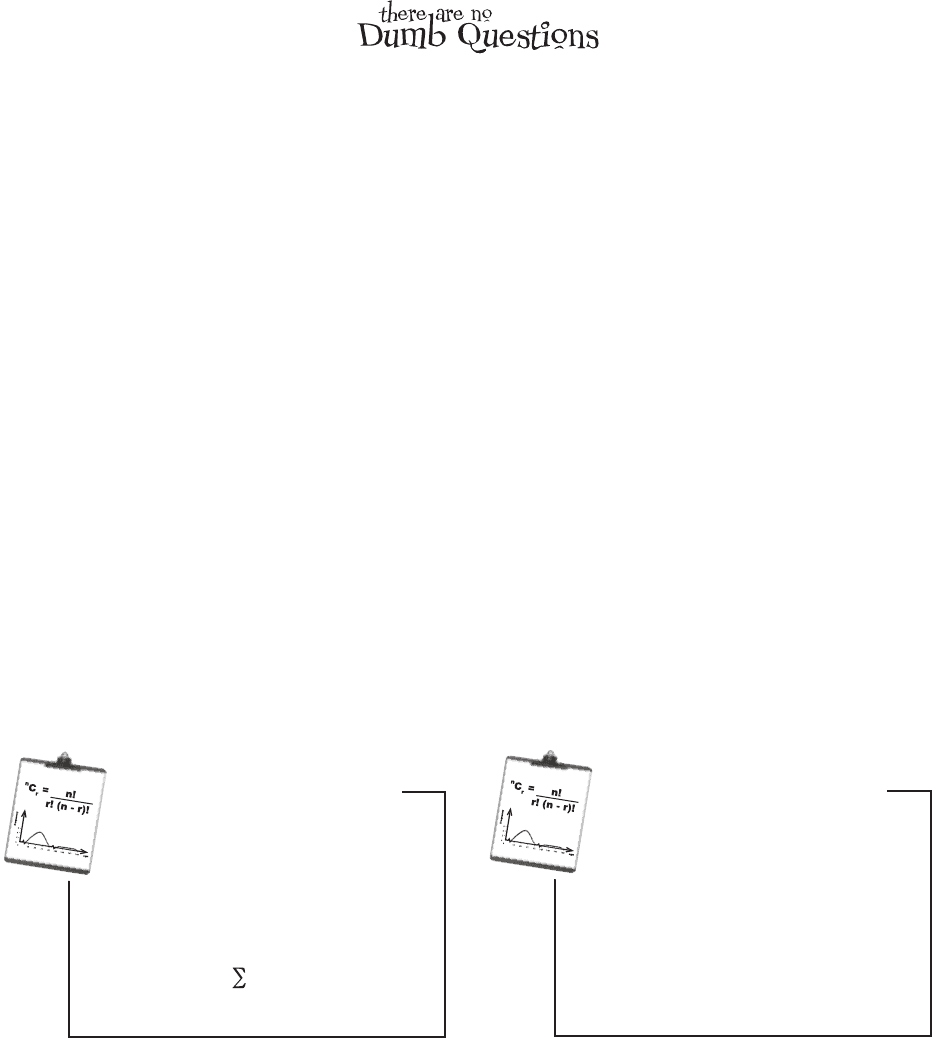
208 Chapter 5
Q:
So expectation is a lot like the
mean. Is there anything for probability
distributions that’s like the median or
mode?
A: You can work out the most likely
probability, which would be a bit like the
mode, but you won’t normally have to do this.
When it comes to probability distributions,
the measure that statisticians are most
interested in is the expectation.
Q:
Shouldn’t the expectation be one of
the values that X can take?
A: It doesn’t have to be. Just as the mean
of a set of values isn’t necessarily the same
as one of the values, the expectation of a
probability distribution isn’t necessarily one
of the values X can take.
Q:
Are the variance and standard
deviation the same as we had before
when we were dealing with values?
A: They’re the same, except that this time
we’re dealing with probability distributions.
The variance and standard deviation of a
set of values are ways of measuring how
far values are spread out from the mean.
The variance and standard deviation of
a probability distribution measure how
the probabilities of particular values are
dispersed.
Q:
I find the concept of E(X - μ)
2
confusing. Is it the same as finding
E(X - μ) and then squaring the end result?
A: No, these are two different calculations.
E(X - μ)
2
means that you find the square of
X - μ for each value of X, and then find the
expectation of all the results. If you calculate
E(X - μ) and then square the result, you’ll get
a completely different answer.
Technically speaking, you’re working out
E((X - μ)
2
), but it’s not often written that way.
Q:
So what’s the difference between a
slot machine with a low variance and one
with a high variance?
A: A slot machine with a high variance
means that there’s a lot more variability in
your overall winnings. The amount you could
win overall is less predictable.
In general, the smaller the variance is, the
closer your average winnings per game are
likely to be to the expectation. If you play on
a slot machine with a larger variance, your
overall winnings will be less reliable.
there are no dumb questions
Variance
Use the following formula to
calculate the variance
Var(X) = E(X - μ)
2
Vital StatisticsVital Statistics
Expectation
Use the following formula to find
the expectation of a variable X:
E(X) = xP(X = x)
Vital StatisticsVital Statistics

you are here 4 209
using discrete probability distributions
Here’s the probability distribution of a random variable X:
x 1 2 3 4 5
P(X = x)
0.1 0.25 0.35 0.2 0.1
1. What’s the value of E(X)?
2. What’s the value of Var(X)?
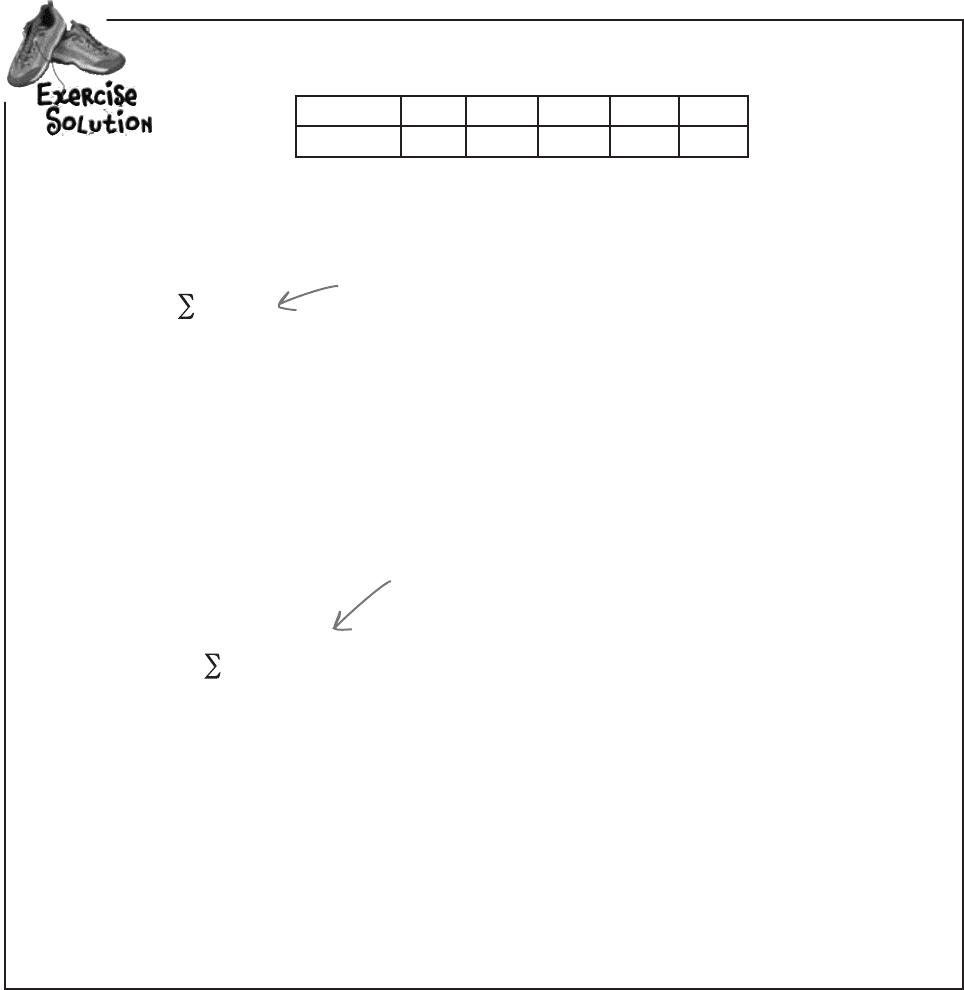
210 Chapter 5
Here’s the probability distribution of a random variable X:
x 1 2 3 4 5
P(X = x)
0.1 0.25 0.35 0.2 0.1
1. What’s the value of E(X)?
E(X) = xP(X=x)
= 1x0.1 + 2x0.25 + 3x0.35 + 4x0.2 + 5x0.1
= 0.1 + 0.5 + 1.05 + 0.8 + 0.5
= 2.95
2. What’s the value of Var(X)?
Var(X)
2
= E(X - μ)
2
= (x - μ)
2
P(X=x)
= (1-2.95)
2
x0.1 + (2-2.95)
2
x0.25 + (3-2.95)
2
x0.35 + (4-2.95)
2
x0.2 + (5-2.95)
2
x0.1
= (-1.95)
2
x0.1 + (-0.95)
2
x0.25 + (0.05)
2
x0.35 + (1.05)
2
x0.2 + (2.05)
2
x0.1
= 3.8025x0.1 + 0.9025x0.25 + 0.0025x0.35 + 1.1025x0.2 + 4.2025x0.1
= 0.38025 + 0.225625 + 0.000875 + 0.2205 + 0.42025
= 1.2475
Multiply each value by
the probability of it
occurring, and take the
sum of all the results.
Go through each value x and work out
what (x - μ)
2
is. Then multiply it by the
probability of getting x. Once you’ve done
that, add the whole lot up together.
exercise solution
